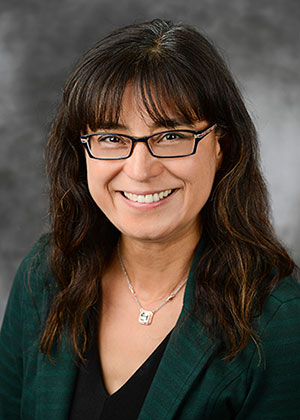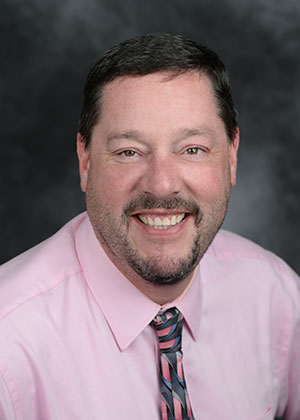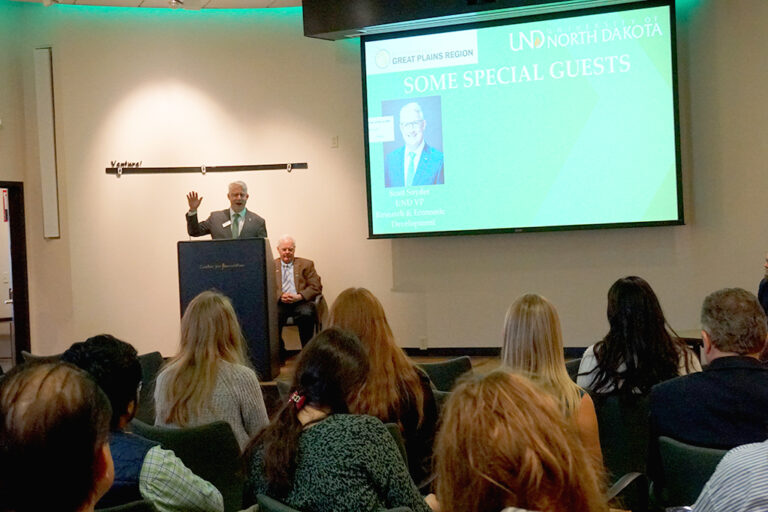Budgeting 101: Sooner rather than later
Arts & Sciences’ quick reaction to Legislature-mandated cuts allowed it to support and protect priorities
Debbie Storrs is a planner.
As soon as she took on the role of dean of UND’s College of Arts and Sciences in 2013, she gathered her new leadership team and started building a strategic plan for the college. The team’s focus was supporting a strong liberal arts mission, establishing a stronger fiscal future and enhancing student academic outcomes.
“It was an inclusive, faculty-driven process that helped shape all sorts of decisions, budgetary and otherwise,” Storrs said. “Before that plan was developed, there was a strategy in place from former deans and the college at large, but I would say it wasn’t as future-looking. It was for immediate response to certain contexts.”
The plan was adopted by the college in the fall of 2014, and not a moment too soon. Late in the fall of 2015, the University informed units about the need to make budget cuts to reconcile a gap in tuition revenue and operating expenses. In February, the call for reduced budgets was compounded by a state-mandated 4.05 percent allotment, which meant UND now faced a $5.3 million reduction. Arts and Sciences was tasked with forming a proportional response in alignment with the college’s large size and overall budget.
“It was a pretty condensed timeframe between the time President Schafer announced the University’s approach and the time the chairs had to give me feedback,” Storrs recalled. “It was about a month. But in that timeframe, we did an enormous amount of contact with chairs and faculty.”

Sense of optimism
Now, as North Dakota enters an especially tough legislative session in January, UND is preparing for the potential of another round of budget reductions. As someone who previously served at an institution that battled through years of cuts, Storrs is keeping a firm hold on optimism.
“When I look at the budget at UND, and how the state has supported UND, it’s better than most states,” Storrs said. “That doesn’t make people here feel much better, but for me, having a newcomer’s perspective, the state is much more supportive of higher education than most of the rest of the nation.
“I believe we’re going to get through it. We’ll have to work hard and make difficult decisions, and we’re going to do that. If we focus on what we do well and communicate and articulate that better to those who have the power to make a difference, we have a better chance of having a more robust budget and future.”
Communication is key
In 2015-2016, communication was critical for Arts and Sciences’ plan to come together. Storrs’ team coordinated emails between faculty and chairs, shared budget numbers that had to be met, asked every department to submit their own 95- and 90-percent recommendations, and someone from the leadership team met personally with every chair to discuss those recommendations. It was also important to Storrs to hold two open forums for staff and faculty to share ideas and ask questions.
“Now is everyone going to be happy about the decisions that were made? No,” said Arts and Sciences Associate Dean Jeff Weatherly. “Are they going to say, ‘We told you what we wanted and you didn’t do what we wanted?’ Well, yes, that’s true. But there are reasons behind those decisions, different factors.”
Those decisions were multifaceted and informed by the college’s already solid strategic plan. That groundwork and the college’s sooner-rather-than-later approach provided the leadership team a roadmap to protect long-term investments that support the college’s priorities.
“We certainly had an idea of where the college should go,” Weatherly said. “One of the main missions was to be the leading liberal arts college in the state, and we kept that in mind through the budget process. That’s the long-term goal, and as administrators your goal is to put your unit in the best possible position to succeed long-term. Budget reductions are not the ideal situation, but you still have to have that mindset.”

Protecting priorities
One budget item that Storrs and her team chose to protect was the development of the college’s Math Active Learning Lab (MALL). Before the budget crisis, Storrs had been meeting with faculty to explore ways to teach math differently and boost the pass rates of important gateway courses like pre-calculus. Math faculty developed a math teaching and learning model in which students learn at their own pace with the help of tutors in a space open early morning to late night. The plan needed space, technology and people.
“It requires some investment on the part of the college. So it’s not cost-saving, as much as it is a real improvement in the academic outcomes of math.” Storrs said. “We didn’t want to create a quick math lab without the training, the research, the right structure, the right resources.”
Storrs pointed to open dialogue between her fellow deans as one of the keys to moving forward through the budget crisis and into planning for the future.
“We also, as deans, have to think about how we generate revenue,” Storrs said. “Can we generate it through more grant productivity? If so, how do you support faculty to do more of that and continue to support creative activity and research that is not grant-funded? And in terms of generating new revenue, maybe it’s through creating new collaborative programs to get new students to UND. Colleges have to be proactive. We can’t just be defensive and responsive to budget reductions. That’s why strategic plans are important.”


